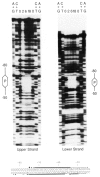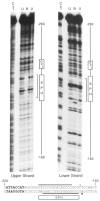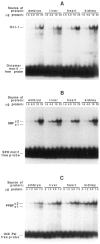Differential protein-DNA interactions at the promoter and enhancer regions of developmentally regulated U4 snRNA genes
- PMID: 1633438
- PMCID: PMC6057390
Differential protein-DNA interactions at the promoter and enhancer regions of developmentally regulated U4 snRNA genes
Abstract
In the chicken genome there are two closely-linked genes, U4B and U4X, that code for different sequence variants of U4 small nuclear RNA (snRNA). Both genes are expressed with nearly equal efficiency in the early embryo, but U4X gene expression is specifically down-regulated relative to U4B as development proceeds. At the present time, little is known about the mechanisms that regulate differential expression of snRNA genes. We have now identified a novel chicken factor, PPBF, that binds sequence-specifically in vitro to the proximal regulatory region of the U4X gene, but not to the proximal region of the U4B gene. PPBF is itself regulated during development and may therefore be a key factor involved in differentially regulating U4X gene transcription relative to U4B. The U4X and U4B enhancers contain distinct sequence variants of two essential motifs (octamer and SPH). The Oct-1 transcription factor binds with similar affinities to both the U4X and U4B octamer motifs. However, a second essential snRNA enhancer-binding protein, SBF, has a 20- to 30-fold lower affinity for the SPH motif in the U4X enhancer than for the homologous SPH motif in the U4B enhancer. A potential role therefore exists for SBF, as well as PPBF, in the preferential down-regulation of the U4X RNA gene during chicken development.
Figures









Similar articles
-
Identification of proximal sequence element nucleotides contributing to the differential expression of variant U4 small nuclear RNA genes.J Biol Chem. 1995 Nov 17;270(46):27629-33. doi: 10.1074/jbc.270.46.27629. J Biol Chem. 1995. PMID: 7499227
-
U4B snRNA gene enhancer activity requires functional octamer and SPH motifs.Nucleic Acids Res. 1990 Dec 25;18(24):7323-30. doi: 10.1093/nar/18.24.7323. Nucleic Acids Res. 1990. PMID: 2259626 Free PMC article.
-
Transcriptional signals of a U4 small nuclear RNA gene.Nucleic Acids Res. 1987 Nov 25;15(22):9239-54. doi: 10.1093/nar/15.22.9239. Nucleic Acids Res. 1987. PMID: 3684593 Free PMC article.
-
Regulation of snRNA gene expression by the Drosophila melanogaster small nuclear RNA activating protein complex (DmSNAPc).Crit Rev Biochem Mol Biol. 2011 Feb;46(1):11-26. doi: 10.3109/10409238.2010.518136. Epub 2010 Oct 6. Crit Rev Biochem Mol Biol. 2011. PMID: 20925482 Review.
-
Transcriptional regulation of human small nuclear RNA genes.Biochim Biophys Acta. 2008 May;1779(5):295-305. doi: 10.1016/j.bbagrm.2008.04.001. Epub 2008 Apr 8. Biochim Biophys Acta. 2008. PMID: 18442490 Free PMC article. Review.
Cited by
-
Differential alterations in metabolic pattern of the spliceosomal UsnRNAs during pre-malignant lung lesions induced by benzo(a)pyrene: modulation by tea polyphenols.Mol Cell Biochem. 2006 Sep;289(1-2):149-57. doi: 10.1007/s11010-006-9158-y. Epub 2006 May 23. Mol Cell Biochem. 2006. PMID: 16718374
-
Structural requirements for the functional activity of a U1 snRNA gene enhancer.Nucleic Acids Res. 1993 Jan 25;21(2):281-7. doi: 10.1093/nar/21.2.281. Nucleic Acids Res. 1993. PMID: 8441636 Free PMC article.
-
Comparison of chicken 7SK and U6 RNA polymerase III promoters for short hairpin RNA expression.BMC Biotechnol. 2007 Nov 19;7:79. doi: 10.1186/1472-6750-7-79. BMC Biotechnol. 2007. PMID: 18021456 Free PMC article.
-
Control of mouse U1 snRNA gene expression during in vitro differentiation of mouse embryonic stem cells.Nucleic Acids Res. 1997 Jun 1;25(11):2197-204. doi: 10.1093/nar/25.11.2197. Nucleic Acids Res. 1997. PMID: 9153321 Free PMC article.
References
-
- Dahlberg J. E. and Lund E. (1988), in Structure and Function of Major and Minor Small Nuclear Ribonucleoprotein Particles (Birnstiel M. L., ed.), Springer Verlag KG, Heidelberg, pp. 38–70.
-
- Forbes D. J., Kirschner M. W., Caput D., Dahlberg J. E., and Lund E. (1984), Cell 38, 681–689. - PubMed
-
- Gunderson S. I., Knuth M. W., and Burgess R. R. (1990), Genes Dev 4, 2048–2060. - PubMed
Publication types
MeSH terms
Substances
Grants and funding
LinkOut - more resources
Full Text Sources
